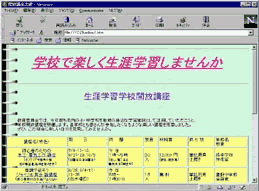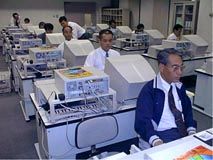Conference to introduce results from the 100-School Networking Project (Phase
II)
Junior high school meeting
Efforts by the Audio and Visual Center to increase networking use at schools,
in the community, and in city government
Jiro Yamashita and Kazuo Miyauchi, Kasukabe Audio Visual Center
1. Introduction
- We provide various services for citizens, teachers, and government
employees at the Kasukabe Audio Visual Center, offering them continuing education
and an information center that serves as our community foundation. We also
create our own educational video programs and computer software.
We chose to participate in the 100-School Networking Project to add new interest
to our regular work and to spread Internet use throughout the city.
2. Sending information via the Internet
- We received equipment for Internet use by participating in the 100-School
Networking Project. We established a group consisting of members from a special
committee from Kasukabe Audio Visual Center, including staff, scholars, staff
from the city hall, and teachers, to examine ways in which education centers,
schools, and the community could use the Internet.
We created a home page to introduce Kasukabe City, the Kasukabe Audio Visual
Center, and our city schools. We began with a very simple home page, and over
time have continued to make improvements.
|
Picture 1
|
 |
(1) How to reach Kasukabe Audio Visual Center
(2) Introducing Kasukabe Audio Visual Center's facilities
(3) Using the facilities and course information
(4) Introducing other facilities at the Center
(5) Work by children and students
(6) Introducing the schools
(7) Information on the flowers of Kasukabe City
(8) Information about facilities for continuing education in the city (picture
1: courses offered)
(9) Links to home pages useful in studying
3. Activities for schools
- The city has twenty elementary schools and ten junior high schools. In FY
1996, computers for office work (two for each elementary school and three
for each junior high school) were upgraded. At a junior high school, forty
computers located in the computer room were networked using an indoor LAN,
making Internet access available to each computer. However, only one of the
schools participating in the Konet plan in Kasukabe has access to the Internet,
and only one elementary school in our city uses computers in their lessons.
(1) Creating home pages for our city schools
- We submitted a proposal to create a home page for each school to the associations
of principals and vice-principals. We received information from the schools,
converted it into HTML at the Audio Visual Center, and published the home
pages. When a school receives e-mail, we print it out and send it to them.
(2) Improving our training system
-
|
Picture 2
|
 |
We added an Internet experience segment to our computer training system for
teachers. We held mainly in-school and basic computer training during summer
vacations. We also held well-received training courses for principals and
vice-principals at night for the interested. We improved training for creating
home pages, offering instruction on creating and updating a school home page
in cooperation with *the Audiovisual Supervisor's Association of Kasukabe
City's Education Training Institute*.
(3) Activities for schools
-
|
Picture 3
|
 |
We helped create a home page for a school participating in the Konet plan,
and held a demonstration to illustrate use of a teleconferencing system. (picture
3) We downloaded material from the Internet for schools in our city to use
in lessons, including ones on "life in regions with heavy snowfall"
and "life in warm regions." We offered advice on using such material.
Children and students began using the Internet in our center in order to collect
material for their research. Our city teachers have free access to the Internet
from our center, and they take advantage of it to gather various material.
AETs (Assistant English Teachers) exchange e-mail with people from their home
countries. We communicate with the Ministry of Education to collect and offer
data. We are also in the process of creating a proposal for Information Education
in Kasukabe City that covers privacy issues, before the time when all of our
schools have access to the Internet.
3. Community Activities
- We offer computer courses and have set up a space at our center where people
can try out a computer and try publishing information about our region via
our home page.
(1)Computing seminar for citizens: Each year, we offer eight basic courses,
four word processing courses, and a spreadsheet course. The maximum number
of students for each course is twenty. We offer both day and night classes
on weekdays and weekends to accommodate a wide range of schedules. Each course
includes an introduction to the Internet. We also offer courses outside the
center.
(2) Experience booth: We set up two computers for simulated use of
the Internet in the study salon on the first floor. We also have computers
in the audiovisual experiencing booth on the third floor, where people can
access the Internet for free. We're happy to report that the number of people
taking advantage of this opportunity is increasing steadily, and we continue
to offer assistance, provided such assistance does not interfere with our
regular work.
(3) Our home page offers various kinds of information: how to use our
facilities, a course catalog, train schedules for Kasukabe station, the progress
of the flower of the Japanese wisteria (our city flower), a list of our 16
mm films, and news concerning new video programs.
4. Activities for city hall employees
- We gather information for city hall employees and offer them instruction
on making use of this information. The city itself currently lacks the facilities
for Internet use.
(1) Training for city hall employees
- We hold a basic training course, co-sponsored by the city hall personnel
department, that offers instruction on computing in the workplace. This course
includes experience using the Internet. After the basic training course, we
teach city hall employees how to use a spreadsheet program. This year we taught
a well-received basic training course on computer use for managers (section
chief and above).
(2) Using the Internet to collect information
- The number of government offices with home pages is rising. One example
is Saitama prefecture's information home page on local history and culture.
People from various departments visit our center to gather information. We
have ties with a home page design firm in Kasukabe city, which creates home
pages for the International Friendship Association, the Young Men's Association,
and the Rotary Club. There are plans to set up a home page for Kasukabe city,
on which city information will be freely available.
5. Conclusion
- Since participating in the 100-School Networking Project, we've had many
opportunities to become familiar with advanced computing techniques. We've
learned a lot from our experiences with participating schools from all over
Japan. In our city, the importance of networking and our center's activities
are finally winning recognition, through our training programs, the spread
of personal computers, and the growing profile of the Internet. Our ability
to promote and support Internet use currently depends on budget and human
resource constraints. There are some factors that encourage the use of the
Internet, two of which are reductions in hardware costs and the establishment
of OCN (Open Computer Network) by NTT. But budget reductions forced by falling
tax revenue have resulted in a certain hesitancy to spend money on equipment
for the Internet, since its benefits aren't readily apparent. People's skills
have continued to improve as a result of two years of continuous training,
and we believe training should be made available to a wider range of people.
More advanced courses are also needed. The people in charge of our center
are working very hard to meet all these challenges.
As an audiovisual center, we want to grow to keep step with advancing technology
and to expand our activities. We would like to link ourselves to other audiovisual
centers throughout Japan and create a distributed database to pool our audiovisual
materials. We are currently discussing a project to network city schools,
public halls, and libraries, which will also make available information on
courses, events, and facility reservations. We would like to connect our center's
network to the Internet and set up terminals for public use, which citizens
would be free to use, to search a database of employment and event information.
Our vision is to grow into a community-based, easy-to-use information center.
We believe the Internet will be an essential part of realizing this vision.
 Conference to introduce results from the 100-School Networking Project (Phase II)
Conference to introduce results from the 100-School Networking Project (Phase II)



 Conference to introduce results from the 100-School Networking Project (Phase II)
Conference to introduce results from the 100-School Networking Project (Phase II)